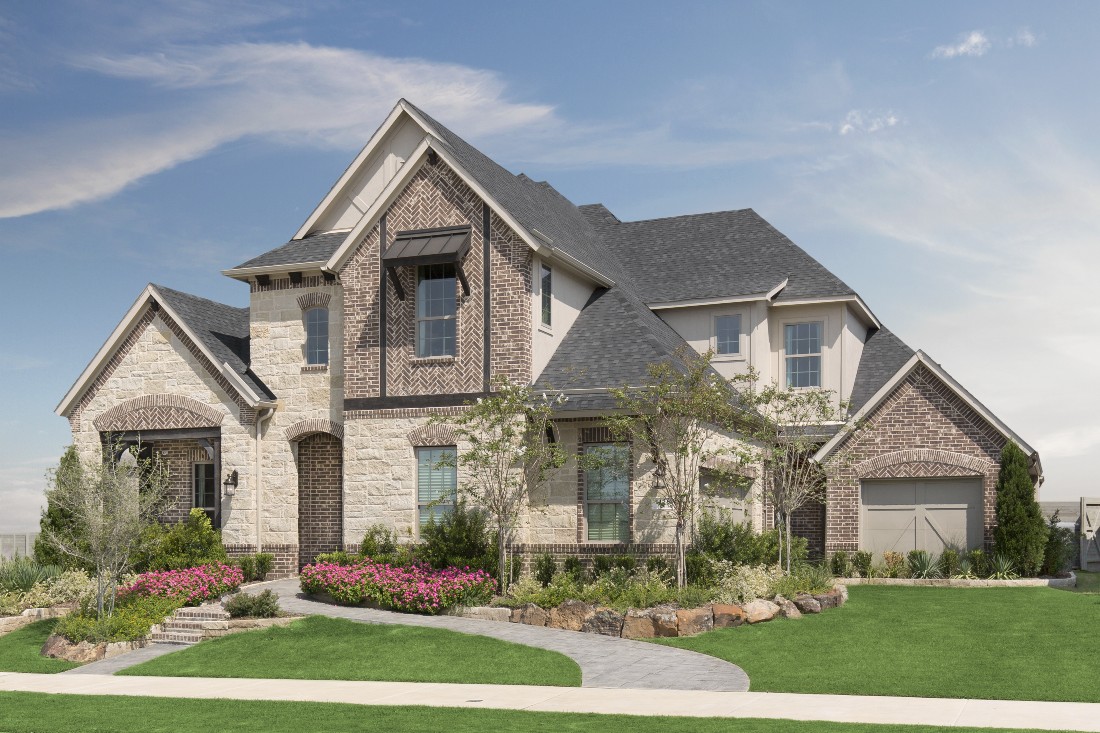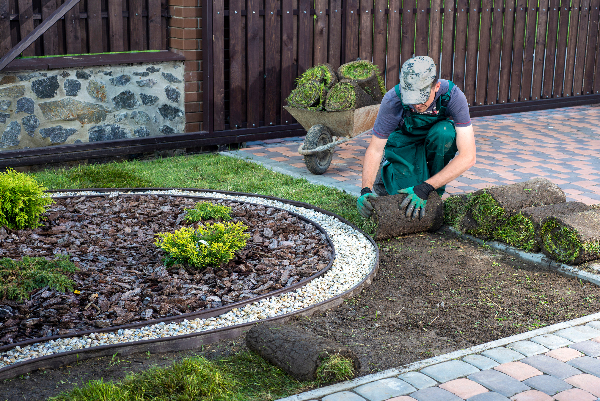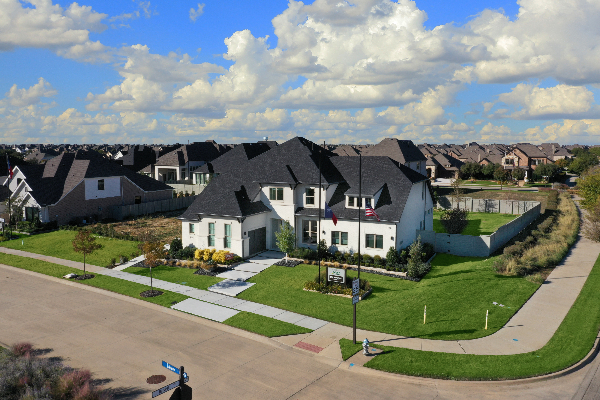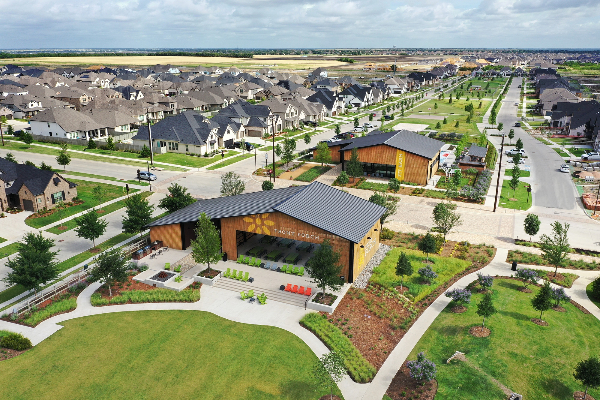
The construction process on your new North Texas home is nearly complete! But what about the yard? Right now, it may be a bare patch of black dirt with some assorted rocks mixed in. The beautiful new home you’ve envisioned won’t be finished until there is a complementary landscape surrounding it. What is involved in new build landscaping and why is it so important? Below, we answer these questions, review the new construction landscaping process, and provide landscaping tips for new homes.
Landscaping does a lot for a home. Adding grass, trees, shrubs, and other living plants around your home enhances its beauty and says you care about the appearance of your neighborhood. The new home landscaping process offers other benefits as well.
Proper landscaping promotes proper drainage around your home and prevents soil erosion caused by wind, water runoff, and gravity — particularly if your yard is on a slope.
Good landscaping can help your home use less energy. Deciduous vines and trees planted to the west and southwest let the sun warm the home during the winter (after the leaves have dropped) and can help it stay cooler in the summer, especially if the plantings block direct sunlight from hitting the roof and windows. Trees and shrubs planted on the north and west sides of a structure can provide a wind break which reduces the impact of chilling winter winds.
A study conducted by Virginia Tech University found that landscaping accounts for as much as 15% of a home’s perceived value. The study found that improving a home’s landscaping increased its value between 5% and 11% depending on location.
A beautiful yard is an enjoyable place to spend time with friends and family. This enjoyment is increased even more if there are attractive areas for cooking, dining, playing, and relaxing. Beautiful new landscaping can help you maximize the use of outdoor living spaces.

What is involved in creating a landscape for a brand-new home? Here’s a high-level primer on the new construction home landscaping process.
Even if you will not install your new home’s landscape yourself, it’s important to have a plan. This plan might be a professional drawing of your yard showing which plants will go where. Or it might just a priority list of items you most want to include such as an entertaining space, a play structure, a fountain, a place to play ball, a flower garden, and the like.
Structures, paths, fences, water features, irrigation, etc. can all be included in your master landscape plan. But don’t worry if you haven’t thought that far ahead. You don’t have to do it all at once and it’s smart to take a large project like landscaping a new construction home in stages. It’s fine to start with trees, turf grass, and shrubs to give them time to become established, then add other items from your plan at a later time.
This is a good time to think about what types of plants work best for your area. If you are doing your own landscape planning and installation, research plants that thrive in your local area’s climate. Consider sunlight needs, cold hardiness, water requirements, soil preferences, and size at maturity when selecting plants. Quality materials are expensive, and you don’t want to invest in plants that will not survive or will outgrow their space.
If you live in a homeowner’s association, be sure to consult the community’s architectural guidelines to be sure your landscape plan conforms before getting too far with your plan. Some HOAs require pre-approval prior to new landscape installations. Some also provide lists of approved/recommended plants, taking the burden of extensive research off your plate. When this is available, take advantage of this excellent resource! You can just review the list and pick your favorites.
If your new construction home’s landscaping is not included in your purchase price, set a budget for your new landscape. How much does landscaping cost for a new home? A basic rule of thumb is that you should probably expect to spend about 10% of your home’s value on your home’s landscape. You can also ask your neighbors what a typical basic new home landscape costs in your area or ask a few professional landscapers for a ballpark price range for a home like yours.
The landscape installation process is governed by how much of your plan will be installed now. If you are implementing your plan all at once, the first step will likely be any hardscaping not installed by the builder, such as a deck, then an irrigation system, followed by trees, turf grass sod, and the rest of your plantings. If you are implementing your plan in several stages, form the foundation for your landscape with trees, grass sod, and shrubs, then add additional enhancements later.

Residents at Harvest by Hillwood in Northlake/Argyle, Texas don’t have to worry about researching plants, setting a budget, hiring installers, or doing it themselves because new construction homes in the community include professional landscaping and an irrigation system. Each builder at Harvest has their own team of professionals who take care of planning, plant selection, and landscape installation just prior to each home’s completion.
A new construction home’s landscape at Harvest will include adapted and native plants that require less water and are able to thrive in our North Texas weather conditions. Community residents can expect to see Bermuda grass in their yard plus trees such as Texas Red Oak, Live Oak and Crape Myrtle, shrubs like Texas Sage, Sunshine Ligustrum, and Kaleidoscope Abelia, and other plantings such as ornamental grasses, ground covers, perennials, and more.
If you are doing a DIY landscape for your new construction home, consider these tips.
Your landscape will only be as good as the soil it’s planted in. If it’s compacted, loosen it with a tiller or pitchfork. Add amendments to enrich the soil and improve drainage. You can also take your soil to the local agricultural extension office to be tested and to get recommendations on how to improve it.
Don’t waste your time and money on plants that won’t tolerate the conditions in your yard. Pay attention to water, drainage, and sunlight requirements, and consider the sizes the plants will be when full grown.
Don’t plant trees too close to your home’s foundation. Trees should be located a minimum of 15’ from a house. For very tall trees, halve its mature height and use that as the minimum distance. So, by this measure, a 60’ tree should be located a minimum of 30 feet from the house.
A landscape needs time to fully develop but be sure you get out and check on your plants frequently. Ensure that your landscape is receiving the right amount of water, and check for diseases, insects, and drainage issues. If there is a problem that you can’t solve on your own, consult experts at your local garden center, a professional landscaper, or horticulturalist.
Residents at Harvest who have questions about their landscape can consult resident horticulturalist Dr. Robert Moon. He is the expert behind the community’s amazing landscape resources including the recommended plant lists, the gardening and watering calendars, the monthly blog on harvesthoa.com, and our quarterly education classes. He is also instrumental in the development of Harvest’s proprietary fertilizer that is available at the Harvest HUB across from Farmhouse Coffee & Treasures!

Do you love making things grow? If so, Harvest by Hillwood may be the perfect place for you to plant yourself! Here in our agrihood, you’ll find that we value a farm-to-table lifestyle and love to work the land. That’s why the centerpiece of our community is the Harvest Farm, where residents have access to their own private garden plots, and can work in the community garden as much (or as little) as they like. But don’t worry, green thumbs are welcome, but not required. For those who need a little help, our on-site, professional farmer is here to lend a hand.
To learn more, stop by for a visit, take a virtual tour or contact us today.
